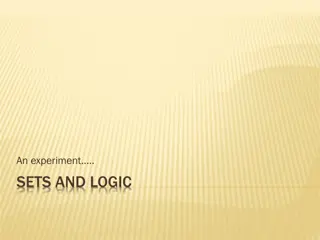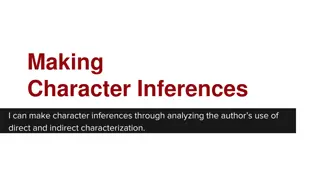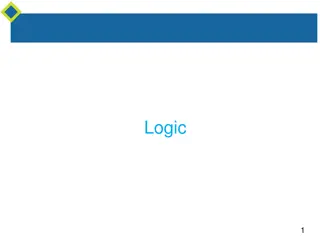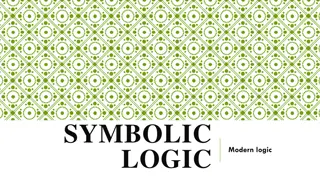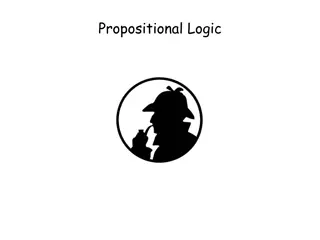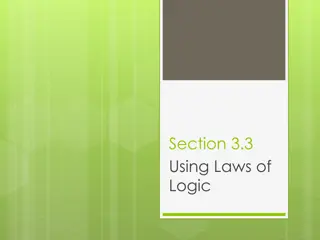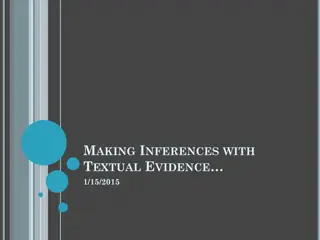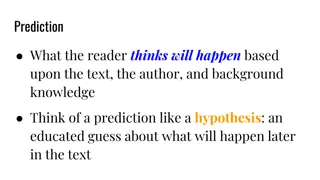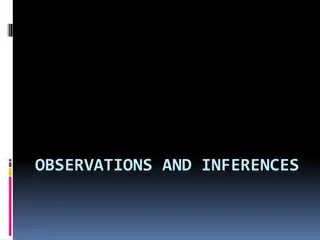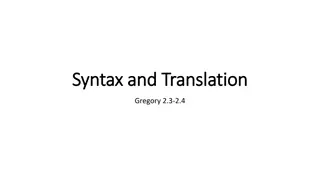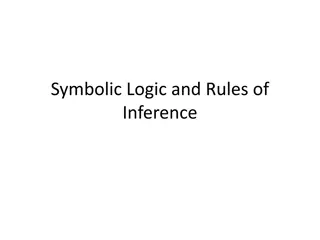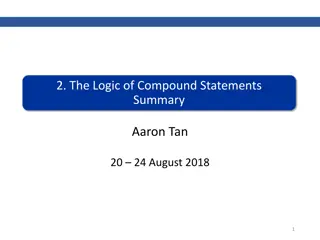Introduction to Symbolic Logic: Understanding Logical Inferences
Logic is the study of reasoning methods to distinguish between correct and incorrect arguments. Symbolic Logic involves representing logic symbolically for easier understanding and manipulation. Logical inferences help in making decisions based on reasoning chains. The content discusses the use of logic in everyday life, logical inferences, symbolic logic representation, and the importance of distinguishing good reasoning.
Download Presentation

Please find below an Image/Link to download the presentation.
The content on the website is provided AS IS for your information and personal use only. It may not be sold, licensed, or shared on other websites without obtaining consent from the author. Download presentation by click this link. If you encounter any issues during the download, it is possible that the publisher has removed the file from their server.
E N D
Presentation Transcript
Symbolic Logic Outline 1. 2. 3. 4. 5. 6. 7. 8. 9. 10. What If a Premise is False? #3 11. What If Both Premises are False? 12. Boolean Values #1 13. Boolean Values #2 14. Boolean Values #3 15. The AND Operation 16. Truth Table for AND Operation Symbolic Logic Outline What is Logic? How Do We Use Logic? Logical Inferences #1 Logical Inferences #2 Symbolic Logic #1 Symbolic Logic #2 What If a Premise is False? #1 What If a Premise is False? #2 17. 18. 19. 20. 21. 22. 23. 24. 25. 26. 27. 28. Another Boolean Operation Joining the Premises Together More on OR What If a Premise is False? #1 What If a Premise is False? #2 What If Both Premises are False? The OR Operation Truth Table for OR Operation Boolean OR is Inclusive What is Exclusive OR? The NOT Operation Truth Table for NOT Operation Symbolic Logic Lesson CS1313 Fall 2024 1
What is Logic? Logic is the study of the methods and principles used to distinguish good (correct) from bad (incorrect) reasoning. Irving M. Copi, Introduction to Logic, 6th ed., Macmillan Publishing Co., New York, 1982, p. 3. Symbolic Logic Lesson CS1313 Fall 2024 2
How Do We Use Logic? Every day, we put logic to work in making decisions about our lives, such as: How to dress? For example: Will it be hot or cold? What to eat and drink? For example: Will we need caffeine to stay up studying? Where to go? For example: Is it a Monday, in which case I need to go to CS1313? Symbolic Logic Lesson CS1313 Fall 2024 3
Logical Inferences #1 We make logical inferencesto reason about the decisions we need to make: It s cold this morning, so I need to wear a sweatshirt and jeans, not just a t-shirt and shorts. I ve got a big exam tomorrow that I haven t studied for, so I d better drink a couple pots of coffee. It s Monday, so I d better be on time for CS1313, so that I m on time for the quiz. Symbolic Logic Lesson CS1313 Fall 2024 4
Logical Inferences #2 We can even construct more complicated chains of logic: 1. I have a programming project due soon. 2. I have been putting off working on it. 3. Therefore, I must start working on it today. Symbolic Logic Lesson CS1313 Fall 2024 5
Symbolic Logic #1 In logic as in many topics, it sometimes can be easier to manage the various pieces of a task if we represent them symbolically. Let D be the statement I have a programming project due soon. Let L be the statement I have been putting off working on my programming project. Let W be the statement I must start working on my programming project today. We can then represent the chain of logic like so: D and L => W Symbolic Logic Lesson CS1313 Fall 2024 6
Symbolic Logic #2 D and L => W This can be read in two ways: D and L impliesW. IfD is true andL is true, thenW is true. Symbolic Logic Lesson CS1313 Fall 2024 7
What If a Premise is False? #1 D and L => W What if L is not true? What if I ve already started working on my programming project? In that case, the statement I have been putting off working on my programming project is not true; it is false. So then the statement D and L is also false. Why? Symbolic Logic Lesson CS1313 Fall 2024 8
What If a Premise is False? #2 D and L => W If the statement L is false, then why is the statement D and L also false? Well, in this example, L is the statement I have been putting off working on my programming project. If this statement is false, then the following statement is true: I haven t been putting off working on my programming project. In that case, the statement W I must start working on my programming project today. cannotbe true, because I ve already started working on it, so I can t start working on it now. Symbolic Logic Lesson CS1313 Fall 2024 9
What If a Premise is False? #3 D and L => W What if D is false? What if I don thave a programming project due soon? Well, statement D is: I have a programming project due soon. So if I don t have a programming project due soon, then statement D is false. In that case, statement W I must start working on my programming project today. is also false, because I don t have a programming project due soon, so I don t need to start working on it today. Symbolic Logic Lesson CS1313 Fall 2024 10
What If Both Premises are False? D and L => W What if both D and L are false? In that case, I don t have a programming project due soon, and I ve alreadygotten started on the one that s due in, say, a month. So I definitely don t need to start working on it today. Symbolic Logic Lesson CS1313 Fall 2024 11
Boolean Values #1 A Booleanvalue is a value that is either true or false. The name Boolean comes from George Boole, one of the 19th century mathematicians most responsible for formalizing the rules of symbolic logic. So, in our example, statements D, L and W all are Boolean statements, because each of them is either true or false that is, the value of each statement is either true or false. http://thefilter.blogs.com/photos/uncategorized/boole.jpg Symbolic Logic Lesson CS1313 Fall 2024 12
Boolean Values #2 D and L => W We can express this idea symbolically; for example: D = true L = false W = false Note that is read as The statement L is false. L = false Symbolic Logic Lesson CS1313 Fall 2024 13
Boolean Values #3 L = false is read as The statement L is false. In our programming project example, this means that the statement I havebeen putting off working on my programming project is false, which means that the statement It is not the case that I have been putting off working on my programming project is true, which in turn means that the statement I haven tbeen putting off working on my programming project is true. So, in this case, L = false means that I already have started working on my programming project. Symbolic Logic Lesson CS1313 Fall 2024 14
The AND Operation From this example, we can draw some general conclusions about the statement S1 and S2 for any statement S1 and any statement S2: If S1 is true and S2 is true, then S1 and S2 is true. If S1 is false and S2 is true, then S1 and S2 is false. If S1 is true and S2 is false, then S1 and S2 is false. If S1 is false and S2 is false, then S1 and S2 is false. Symbolic Logic Lesson CS1313 Fall 2024 15
Truth Table for AND Operation S1 and S2 We can represent this statement with a truth table: S2 AND true true false false S1true false false false To read this, put your left index finger on the value of statement S1 (that is, either true or false) at the left side of a row, and put your right index finger on the value of statement S2 at the top of a column. Slide your left index finger rightward, and slide your right index finger downward, until they meet. The value under the two fingers is the value of the statement S1 and S2. Symbolic Logic Lesson CS1313 Fall 2024 16
Another Boolean Operation Suppose you want to know whether today is a good day to wear a jacket. You might want to come up with rules to help you make this decision: If it s raining in the morning, then I ll wear a jacket today. If it s cold in the morning, then I ll wear a jacket today. So, for example, if you wake up one morning and it s cold, then you wear a jacket that day. Likewise, if you wake up one morning and it s raining, then you wear a jacket that day. Symbolic Logic Lesson CS1313 Fall 2024 17
Joining the Premises Together We can construct a general rule by joining these two rules together: If it s raining in the morning OR it s cold in the morning, THEN I ll wear a jacket today. Symbolic Logic Lesson CS1313 Fall 2024 18
More on OR We can apply symbolic logic to this set of statements, like so: Let R be the statement It s raining in the morning. Let C be the statement It s cold in the morning. Let J be the statement I ll wear a jacket today. We can then represent the chain of logic like so: R orC =>J This can be read in two ways: R or C implies J. If R is true or C is true, then J is true. Symbolic Logic Lesson CS1313 Fall 2024 19
What If a Premise is False? #1 What if C is not true? For example, what if it s hot in the morning? In that case, the statement It s cold in the morning is not true; it is false. So then what about the statement R or C ? Well, even if it s hot in the morning, if it s raining then you want your jacket anyway. In other words, if R is true, then even though C is false, still R or C is true. Symbolic Logic Lesson CS1313 Fall 2024 20
What If a Premise is False? #2 Suppose that it s not raining in the morning, but it is cold. Then the statement It s raining in the morning. is false, and the statement It s cold in the morning. is true. In which case, the statement I ll wear a jacket today. is true. In other words, if R is false and C is true, then R or C is also true. Symbolic Logic Lesson CS1313 Fall 2024 21
What If Both Premises are False? What if both R and C are false? In that case, it s neither raining nor cold in the morning, so I won t wear my jacket. In other words, if R is false and C is false, then R or C is false. Symbolic Logic Lesson CS1313 Fall 2024 22
The OR Operation From this example, we can draw some general conclusions about the statement S1 or S2 for any statement S1 and any statement S2: If S1 is true and S2 is true, then S1 or S2 is true. If S1 is false and S2 is true, then S1 or S2 is true. If S1 is true and S2 is false, then S1 or S2 is true. If S1 is false and S2 is false, then S1 or S2 is false. Symbolic Logic Lesson CS1313 Fall 2024 23
Truth Table for OR Operation S1 or S2 We can represent this statement with a truth table: S2 OR true true false true false S1true false true To read this, put your left index finger on the value of statement S1 (that is, either true or false) at the left side of a row, and put your right index finger on the value of statement S2 at the top of a column. Slide your left index finger rightward, and slide your right index finger downward, until they meet. The value under the two fingers is the value of the statement S1 or S2. Symbolic Logic Lesson CS1313 Fall 2024 24
Boolean OR is Inclusive In symbolic logic, the Boolean operation OR is inclusive, meaning that it can be the case that both statements are true. In the jacket example, if it s raining andit s cold, then you ll take your jacket. So Boolean OR is equivalent to and/or in normal colloquial speaking. Symbolic Logic Lesson CS1313 Fall 2024 25
What is Exclusive OR? We know that the Boolean OR operation is inclusive. But, there s also such a thing as exclusive OR, denoted XOR. XOR is like OR, except that if both statements are true, then the result is false. We WON T be worrying about XOR in this course. Symbolic Logic Lesson CS1313 Fall 2024 26
The NOT Operation Boolean logic has another very important operation: NOT, which changes a true value to false and a false value to true. In real life, you ve probably said something like this: I care what you think NOT! Notice that the NOT exactly negates the meaning of the sentence: the sentence means I don t care what you think. From this example, we can draw some conclusions about the statement not S, for any statement S: If S is true, then not S is false. If S is false, then not S is true. Symbolic Logic Lesson CS1313 Fall 2024 27
Truth Table for NOT Operation NOTS We can represent this statement with a truth table: S NOT true false true false Symbolic Logic Lesson CS1313 Fall 2024 28







